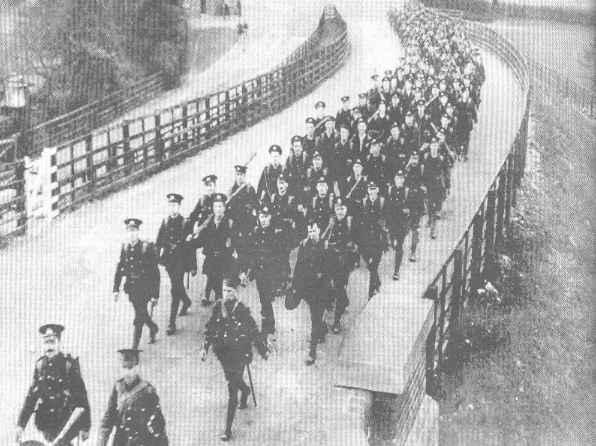Jack Davies, formerly of the 6th Battalion Duke of Cornwall LI.
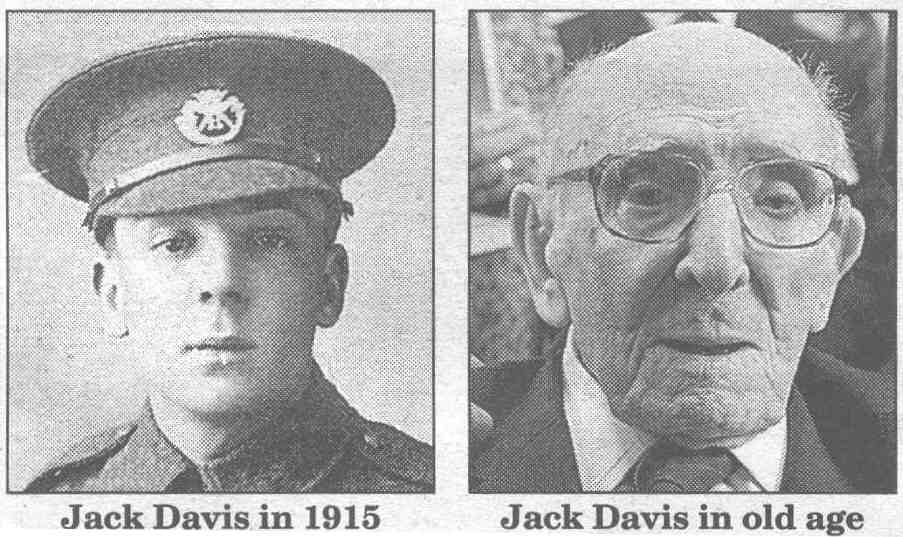
The latest news from the press.
Source: Various November 2003.
Battlefield archeologists uncovered remains of a former WW1 British trench whilst digging prior to the construction of the new A19 motorway.
Full BBC story - http://news.bbc.co.uk/go/em/fr/-/1/hi/world/europe/3256553.stm
Source: Shropshire Star 21st July 2003.
Jack Davies, formerly of the 6th Battalion Duke of Cornwall LI.

Source: BBC Web Site 3rd April 2003.
French Prime Minister Jean-Pierre Raffarin has pleaded for trans-Atlantic tolerance after graffiti was daubed on a British war cemetery in northern France.
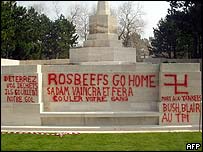
Full story - http://news.bbc.co.uk/1/hi/world/europe/2907701.stm
Source: THE SHROPSHIRE STAR 10th July 2002.
Shrewsbury
writer and Historian Joy Cave has died at the age of 80. Mrs Cave, of
Ridgebourne Road, Shrews bury, was the wife of former Shrewsbury Town Clerk
Norman Cave. The former teacher moved to the town with her husband in 1960 when
he became deputy town clerk, before eventually taking over the post and
remaining there until 1974.
After moving to the county town, Mrs Cave took up a post at the William Brookes School, in Much Wenlock, where she taught English and history. Later in her career Mrs Cave moved to the Priory School for Girls; in Shrewsbury.
She
also formed the West Midlands branch of the Western Front Association, an
organisation for people interested in the history of the First World War.
Her
particular interest was the role of the Newfoundland regiment, a battalion which
lost more men than any other among the allies in the Battle of the Somme. Mrs
Cave wrote three books on the subject and was regarded as the UK's expert on the
regiment. ,
She was
admired and consulted widely by writers and television producers over the years.
As well as her great passion for regimental history, her other hobbies included
golf and reading, particularly the works of Charles Dickens. Mr and Mrs Cave had
one daughter, Pat, who is married to the vicar of Ellesmere, the Rev Philip
Edge. There are also three grandchildren and one great-grandchild.
Mrs
Cave's service and cremation will take place at Emstrey Crematorium, in
Shrewsbury, on Thursday at 10.40am.
Source: THE SHROPSHIRE STAR 25th July 2002.
Three First World War veterans were feted through the
streets of Ypres today when they returned to recall the battlefield horrors. The
three, all more than 100 years old, were special guests at the 75th anniversary
of the Menin Gate Memorial, erected in honour of the thousands of soldiers who
died. The memorial's walls carry the names of 54,896 of the missing. Almost
35,000 more of those who disappeared during the battles of Ypres Salient are in
a neighbouring cemetery in Passchendaele. Today the Duke of Kent, president of
the Commonwealth Graves Commission, spoke at the memorial service of their
sacrifice. Then the oldest of the three veterans present,
Jack Davis, 107, read the exhortation: "They shall grow not old as we that are left grow old. .." His strident tones from his wheelchair beneath the Menin Gate arch were the most moving point of an emotional one-hour ceremony. Afterwards Mr Davis, Harry Patch, 104, and Arthur Halestrap, 103, were all wheeled through the streets to a reception, greeted with smiles and words of encouragement by passers-by.
Source: THE INDEPENDENT 5th March 2002.
Revised
airport plan threatens more Somme graves
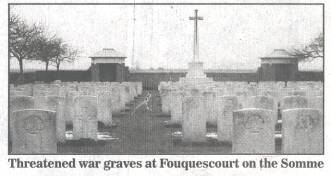 AMENDED
PROPOSALS to build an international airport on the Somme threaten 20 times as
many British and Commonwealth war graves as the original plan, which was angrily
opposed by the British Government and veterans' groups. After fierce opposition
from locals, the £3.5bn project for a third commercial airport to serve Paris
has been shifted 10 miles to the south. The original plans, which were announced
last year, would have forced the removal of two British cemeteries and 66
graves. The new proposals threaten up to eight British and Commonwealth
cemeteries and 1,248 graves. The re-siting of the airport spares a vast German
cemetery with 22,665 graves at Vermandovillers and a large French cemetery with
6,500 graves at Lihons, but another substantial French cemetery at Maucourt,
with 5,000 graves, and a British one at Fouquescourt, with 376 graves, lie at
the centre of the proposed new site.
AMENDED
PROPOSALS to build an international airport on the Somme threaten 20 times as
many British and Commonwealth war graves as the original plan, which was angrily
opposed by the British Government and veterans' groups. After fierce opposition
from locals, the £3.5bn project for a third commercial airport to serve Paris
has been shifted 10 miles to the south. The original plans, which were announced
last year, would have forced the removal of two British cemeteries and 66
graves. The new proposals threaten up to eight British and Commonwealth
cemeteries and 1,248 graves. The re-siting of the airport spares a vast German
cemetery with 22,665 graves at Vermandovillers and a large French cemetery with
6,500 graves at Lihons, but another substantial French cemetery at Maucourt,
with 5,000 graves, and a British one at Fouquescourt, with 376 graves, lie at
the centre of the proposed new site.
Lionel Jospfu, the French Prime Minister, promised to heed British anxieties at the Anglo-French summit in London three months ago. "France has, naturally, the greatest respect for the graves of those soldiers who fell on our side - and even on the other side," he said. "If necessary; a solution will be found, in full consultation with our British friends."
In
fact, the amended draft proposals appear mostly to have responded to the
energetic opposition of a cluster of threatened villages north of the town of
Chaulnes and the objections of the larger towns of Amiens and Saint Quentin,
which would have been under the flight path of the more northerly site. Germany;
which made the least fuss about the original plan, has benefited most from the
change. The huge German war cemetery at Vermando- villers will remain untouched.
Almost as many French graves are
threatened by the new plan as the original one and many times
more British and Commonwealth ones. The greatest concern is for the cemetery at
Fouquescourt, containing British, Australian, Canadian and South African graves
from March 1918, which lies at the heart of the proposed airport site.
North
of Ypres, scene of three bloody and protracted battles in the First World War, a
campaign is being waged to protect six cemeteries from a proposed road linking
Ypres with Kortrijk on the Belgian coast. The road is seen as vital to the
area's prosperity, but protesters say it would violate the sanctity of the war
dead.
Source: THE DAILY MAIL 2nd March 2002.
Is this brave man the fallen Tommy of Passchendaele?
UNDER fierce shell fire and in driving rain, Thomas
Jenkins bravely made his way across No Man's Land towards the enemy lines. An
overnight barrage by more than 3,000 guns had briefly silenced the Germans.
Poison gas sent over by the British billowed
across the battlefield. But now murderous artillery salvoes roared back and machine- gun fire
erupted from 300 enemy pill-boxes -mowing down hundreds
of the assaulting troops. It
was the early morning of Tuesday, July 31, 1917 and Private Jenkins, a
24-year-old soldier in the Royal Welch F\1siliers, did not have long to live. He
became one of an eventual 270,000 British casualties of the Third Battle of
Ypres, a First World War campaign grimly immortalised by the name of
Passchendaele the Flemish village on a strategic ridge above Ypres that was the British objective. Like
so many of those killed in the hell of Flanders, his heavily laden body
disappeared into the deep quagmires of shell-blasted mud seemingly fated to be
one of the thousands that would have no known
grave. But
earlier this week, an intriguing picture of the huddled skeleton of an
infantryman unearthed on the battlefield was released by archaeologists.
He appeared to be
hugging a weapon tightly against his chest, and had equipment including an
ammunition belt wrapped around his torso, as if cut down during an advance. Now,
it is believed, that poignant unknown warrior who was found last summer could be
Thomas Jenkins. One vital clue is the metal RWF regimental shoulder flash,
signifying the Royal Welch Fusiliers, that was found with the skeleton. Other
indicators of his identify are a battered steel helmet, three pieces of khaki
tunic, a pair of infantry man's
boots and a pack full of kit. This includes an entrenching spade, a broken pipe and pencils,
toothbrush, blue water bottle and an ampule of iodine used for treating
wounds.
Most compellingly, the body was found at the very spot
near the village of Boezinge where Private Jenkins's 16th Battalion of the RWF
began its assault on the Pilckem Ridge sector at the start of the
Passchendaele offensive. 'I
am convinced the soldier was a Royal Welch Fusilier who was killed on July 31
while taking part in the Battle of Pilckem Ridge,' said archaeologist Aureel Sercu. 'His battalion was advancing towards a sap, or small
German trench, jutting towards the British lines which would have been very well
protected. He certainly sank into the mud after being killed, while the bodies
of other members of his regiment were saved.' Sixteen officers and 456 men of the 16th Battalion
advanced that morning after zero hour at 3.50am. The RWF had five battalions in
action and the 16th's losses would have made up around a fifth of the regiment's
total of 37 deaths. Some bodies were found. This means there is a better than a
one-in-five chance that the soldier is
Private Jenkins. 'Such
statistics are incredible,' said David Bownes, curator of the RWF Regimental
Museum in Caemarfon,
North Wales. 'The
fact that we can narrow the identity of the man to such a small number means
there is a very good chance he could be Jenkins.' Belgian police are examining
forensic evidence and the investigation into the identity of the body, which has
been handed over to the Commonwealth War Graves Commission, will now centre on the
young private. Thomas
John Jenkins volunteered on the outbreak of war in August 1914, mainly because
of a sense of patriotic duty, but also to escape the humdrum routine of life in
the village of Pontrhydfendigaid, near Aberystwyth, mid Wales, where he lived
with his parents
Jenkin and Margaret. The
third of four
brothers he also had three sisters Private Jenkins was known to his family
and friends as Johnnie, after his middle name. The family lived in an end of terrace house called
Butter Hall, which remains to this day. His father was an undertaker and
carpenter and his son was also training to be an undertaker. The
Jenkins’s were Baptists, and sang in a choir at the local Carmel Chapel. Rowland Arch, whose mother Rachel was a cousin of
Private Jenkins, said yesterday: 'Johnnie had a beautiful bass voice, and all
the others were tenors, so his father used to sing bass with him. After his
death, none of us knew what had happened to him. ' David Jenkins, Private Jenkins's nephew who now lives in Lanark
said yesterday: 'I always wanted to know what had happened to our Uncle John. 'His
fate always intrigued me. I went to northern France a few years ago and was
horrified by the rows
of graves.' After
enlisting as RWF Private 45179, the new recruit travelled to Llandudno, North
Wales, for his basic training. In August 1915, the 16th Battalion moved to
Winchester before finally departing for the Continent in December. The regiment which included the poets Siegfried Sassoon and Robert Graves
was involved in the ill-fated Somme campaign the next summer and suffered appalling
casualties. With
the loss of so many comrades, the 16th Battalion was a shadow
of its former self by the time of the Passchendaele offensive. 'All of the
battalions, which should have been made
up of around 1,000 men at the start of the war, were well below full strength by
1917,' said Mr Bownes. 'Men from all over Britain enlisted, to the extent that
the 2nd Battalion was being called the Birmingham Fusiliers. 'Jenkins would have been a very experienced
soldier by this time, but morale would have been very low following the
slaughter on the Somme.'
By the time
Passchendaele village -which had been wiped off the face of the Earth was
finally reached in early November 1917, its capture turned out to be futile, a
few miles of tortured ground gained for a casualty toll that defied belief.
LlewelIyn Wyn Griffith, another Welch Fusiliers writer, likened the experiences
of men such as Private Jenkins to 'a living hell, calling the battles 'the crucifixion
of youth'. The
name of Thomas Jenkins is inscribed on the war memorial in his village and on
the Menin Gate in Ypres -along with 54,364 other Empire soldiers who died in
Flanders and have
no known grave. Every
evening at 8pm, traffic is halted and buglers step under the Gate, a vast
archway across a main road, to sound the Last Post in tribute to the lost ones. Now,
if he is finally identified 84 years after he died serving King and Country, one
young Welshman may at last be buried with the honour befitting his sacrifice.
Source:
THE DAILY MAIL 2nd March 2002.
HE
lies as he fell on the battlefield 85 years ago. Perhaps
no more than a teenager when he went to war, and possibly British, the soldier
still clutches his gun. His knees are
raised, as if in defensive posture, and one arm lies protectively across
his body. Archaeologists do not know his name,
only that he was the victim of a gas attack on a Belgian
battlefield in 1917. Poignantly, the helmet that would
have protected him from enemy fire still shields his skull. And his feet remain
encased in the remnants of boots that once kept out the mud and filth
of World War I trenches. Archaeologists will be seen
uncovering the skeleton on BBC2's Meet the Ancestors on March 6. The
field where he died, just out- side the village of Boezinge, a few mile&
from Ypres, had remained untouched since the 1918 Armistice.
The
owner, a doctor, insisted on preserving the site as a memorial to
those who were killed. But after his death the land was
sold to property developers, who are now building an industrial estate
there. Three years ago, however, a group of
archaeologists began one of the biggest excavations on the Western Front after
mechanical diggers, starting to clear the area for devel- opment, stumbled
across the remains of an entire battlefield. From
1915 to 1917, Ypres was among the most fought-over areas of the Great War. During
years of horrific trench warfare, more than 250,000 British and Allied
servicemen lost their lives around the little Flemish town
they called Wipers. The bodies of an. estimated
55,000 British Empire soldiers were never found. Since
the excavation at Boezinge began about 70 skeletons of British and Commonwealth,
as well as French and German, soldiers have been discovered. Many
lay side by side, at a depth of around 3ft, with their rusting rifles,
ammunition and personal belongings. But identification of the skeletons, which
have now been buried in military cemeteries, has
been difficult. Their uniforms were in tatters and many
of their leather dog tags had long since rotted away. Today
a bumpy green field bordered by an expanding industrial estate, the site was
once a scene of carnage with the two sides confronting each other across 40 yards
of cratered mud. The Germans first unleashed poison gas there in 1915. Although
the field is one of the most battle-scarred parts of Flanders, it has little
mention in the history books. Archaeologists,
however, have discovered an astonishing collection of military hardware as well
as one of the best-preserved
infrastructures of trenches and dug-outs.
They
have unearthed helmets and bayonets, bugles, rifles, pistols and caseloads of
ammunition preserved in the dense clay. Also found were watches, whistles,
cutlery, crucifixes, rings, iodine capsules, candles, tins of bully beef, a rum
bottle, a jar of Bovril, a French dictionary, playing cards and a tiny ivory
monkey for pushing tobacco into a pipe. There
was also a razor that belonged to Private George Parker, a 23-year-old Yorkshire
man who was killed in 1915 and buried nearby.
Early
finds are reported to have been marked with the insignia of the Northumberland
and Lancashire regiments.
Predictably,
hundreds of shells and grenades, many unexploded and some containing lethal gas,
have also been discovered. An
estimated 1.5billion shells were fired on the Western Front, millions of which
landed in soft mud and failed to detonate. To this
day, the Belgian army collects more than 200 tons of decaying munitions left at
the roadside by farmers every year. The
group of Belgian archaeologists freely give their time to provide the war dead
with a dignified resting peace, 'When finally laid to rest in a’ Commonwealth
War Graves Commission cemetery, a soldier's coffin will typically contain bones;
uniform fragments, badges, buttons and even shaving brushes or
combs. All other artefacts that cannot
definitely be linked to human remains are offered to the In Flanders Fields
museum in Ypres. In Meet the Ancestors, cameras followed the archaeologists as
they attempted to uncover the identities of the men found and what happened on
the days they died.
A
BBC spokesman said: 'What1s revealed provides a unique insight into what life
must have been like on the Western Front.'
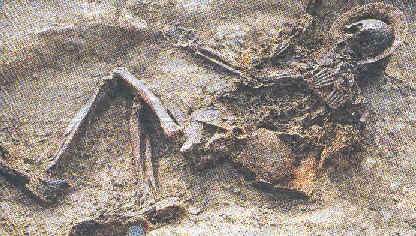
Source: THE DAILY TELEGRAPH 20th January 2002.
A new book claims that the War Graves Commission wrongly
identified the burial place of the author’s son (by David Harrison).
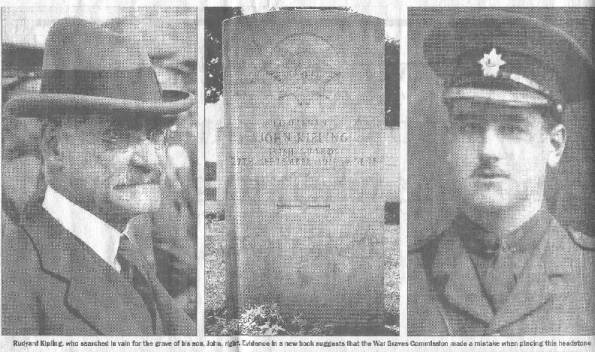
THE
MINISTRY of Defence is investigating new evidence that a First World War grave
was wrongly identified as the last resting place of Rudyard Kipling's only son.
A new book. My Boy Jack?, claims that the Commonwealth War Graves
Commission which announced 10 years ago that the grave was John Kipling's had
confused the author's son with a soldier of a different rank.
John
Kipling died on September 27, 1915 in the Battle of Loos one of the war's
fiercest battles just weeks after arriving on the Western Front in northern
France.
Rudyard
Kipling, who had used his contacts to obtain an officer's com- mission for his
son, and his wife, Carrie, spent much of their last years in a poignant but
fruitless attempt to find his body. Seventy-seven years after John's death, in
1992, the commission said that it had established that a previously unidentified
Irish Guards lieu- tenant -whose body was found on the battlefield and buried at
St Mary's military cemetery in Loos was Kipling's long-missing son. The grave
was duly inscribed: "Lieutenant John Kipling, Irish Guards, 27th September
1915, Age 18," and has been visited by thousands of British "war
pilgrims" in the past decade. The commission was delighted that it had
"solved" a decades-old mystery.
Now,
however, research by Major Tonie Holt and his wife, Valmai, authors of numerous
works on war graves, has found that the commission got it wrong. Their findings
are supported by a number of independent experts, including Capt David Horn, a
former Grenadier Guardsman and curator of the Guards Museum, and Michael
Johnstone, a military historian.
The
commission has referred the claims to the MoD, which said last night that it was
considering the new evidence "very carefully" and expected to make an
announcement "within weeks".
In
the book, the Holts argue that the commission's error stems from the assumption
that John Kipling was a full lieutenant on the day he went missing. Norm
Christie, a commission researcher, had concluded that, with all Irish Guards
lieutenants from the time accounted for, except one, the W1known soldier had to
be John Kipling.
The
Holts, however, examined letters, regimental papers and Rudyard Kipling's own
research, and say that they have established "beyond doubt" that John
Kipling was a second lieutenant at the time of his death and was wearing the
uniform of that rank: with one "pip" on each shoulder. The unknown
soldier was a full lieutenant with two "pips" on each shoulder.
The
Holts say that the confusion almost certainly arose because John Kipling was
promoted to lieutenant after his death. The short-sighted young man sailed for
France on August 16, 1915 as a second lieutenant in the 2nd Battalion of the
Irish Guards. He went missing and was probably killed barely six weeks later.
His
promotion to lieutenant was announced in the London Gazette on November
11, 1915 after he was killed although it was shown as backdated to June, 1915;
more than three months before his death. The authors quote letters written by
John Kipling, showing that he "almost certainly" did not know about
his promotion in advance. In one, written on Sunday, September 19, 1915, when
John was eight miles from
Loos,
he asks his father for an aluminium identification disc, "with a string
through it". To illustrate what 1 wanted, he drew the disc and wrote inside
it: "2nd Lieutenant John Kipling, C of E, Irish Guards."
Rudyard
Kipling used his post-war job with the commission to scour the battlefields of
the Western Front the hope that he might find his son’s body, but died in
January 1936 without having done so. The Holts say in the book, highlighted in
this week's BBC History magazine: "As far as Rudyard was concerned
John's promotion had not come through at the time he was killed."
Mrs
Holt said last night: "We a nearly 100 per cent certain that we have proved
that the grave is not John Kipling's. The key is that we have shown almost
beyond any doubt that John Kipling was regarded as second lieutenant.”
Michael
Smith, the Vice-president of the Kipling Society, said: "I think the Holts
are right about Jack Kipling It has been very nice; for the past nine years, to
think that we could visit the real grave, but for accuracy's sake the truth has
got to come out."
Source: THE COMMONWEALTH WAR GRAVES COMMISSION web site (Whats New) 22nd January 2002.
STATEMENT ON THE GRAVE OF LIEUTENANT JOHN KIPLING
Lieutenant John Kipling went missing presumed killed at the Battle of Loos in September 1915 and was subsequently commemorated by the Commonwealth War Graves Commission on the Loos Memorial in France.
In March 1992 evidence was accepted as linking Lieutenant John Kipling to the previously "Unknown British Officer, Lieutenant, Irish Guards" (the wording on the headstone) in St Mary's Advanced Dressing Station Cemetery in France. This was accepted and a headstone for Kipling erected over the grave.
Mr and Mrs Holt, as part of the research for their book, My Boy Jack, examined the case and questioned the identification.
Since 1992 the Commission has received an increasing number of requests to identify previously unidentified casualties and has concluded that the Commission's member governments should have responsibility in matters relating to the identity of their respective war casualties. It was therefore agreed that the case of Kipling should be referred to the British Government (Ministry of Defence) for its views in relation to the original case and the additional material supplied by the Holts.
The Commission is awaiting the MOD's decision and will make their findings public at the appropriate date.
Source: THE SHROPSHIRE STAR 12th January 2002.
MP in fight to rescue historical battlefield site
North
Shropshire MP Owen Paterson is Iadding his support to the fight to
stop a major road destroying a "special and historic" part of a World
War I battlefield in Belgium.
Michael
Maertens, a senator from Ellesmere's twin town of Diksmuide, has written to Mr
Paterson to highlight the issue. The Flemish Regional Government
is planning to build the road through Pilckem Ridge, near Ypres, where up to
500,000 soldiers died during the Great War.
In his letter
Mr Maertens said: "The Pilckem Ridge is a special historic place to
commemorate and to respect all those brave men who defended in this battle with
their lives western democracy. It is visited every year by about 350,000
Commonwealth tourists, a quarter of them young schoolboys and girls."
He said: The
Flemish Regional Government was planning in a very short time the destruction of
the Pilckem Ridge site by a road construction, cutting the site into two pieces
and so destroying the general view on the battlefield.
"Two-thirds
of the Ypres Salient have already disappeared through the construction of the A19
and Bellewaerde Park. The last and historically most important third of the
Ypres Salient stays untouched."
Mr Paterson is
planning to write to the War Graves Commission and the Government.
He said:
"1 do think it is extremely important that the Commonwealth War Graves
continue their work and the battlefields are pre- served. "
He is also
planning to con- tact Ellesmere Town Council about the issue.
Source: THE COMMONWEALTH WAR GRAVES COMMISSION web site (Whats New) 16th January 2002.
CONSTRUCTION OF A19 MOTORWAY NEAR IEPER
Concerns have been raised that proposals to extend the A19 Motorway near Ieper in Belgium will disturb burials on the First World War "Ypres" battlefield.
There have been proposals to extend the A19 for some time, but it is understood that the final route will not be decided until later this year. The Commission's principal concern is that Commonwealth war cemeteries, for which it is responsible, should not be disturbed and the Belgiun authorities have indicated that this will be avoided, as with previous road construction projects in Belgium.
The Commission has no
responsibility for the battlefields themselves but it would be concerned should
previously undiscovered remains be disturbed during the course of construction
work. Should the remains of Commonwealth forces be discovered, we would expect
them to be handed over to the Commission for burial in one of its war
cemeteries.
Source: Paul Reed (author and of Somme Battlefields Tours) 17th November 2001 reports.
Over the bodies of the living and the dead, the French government will plough ahead with plans for an international airport on the Somme battlefields and war cemeteries 80 miles north of Paris.
Despite the collapse in air travel since 11 September and despite evidence that Paris has no pressing need for a third big airport, Lionel Jospin, the Prime Minister, will approve plans tonight to build a futuristic terminal at Chaulnes, almost halfway between Paris and Calais. The government hopes eventually that the airport, designed for long-haul flights, will draw traffic from Britain and other countries.
At least one village will have to be destroyed and three largely dismantled to make way for the airport, next to the high-speed railway to London, Brussels and Lille. The site, controversial for several reasons, will force the first mass removal of graves of soldiers killed in the First World War.
A small British cemetery containing the remains of 20 soldiers killed in March 1918, on land granted "in perpetuity" by the French state, like all British war cemeteries, falls within the proposed airport boundary. So does a large French military cemetery, also containing six British graves.
The 15-year construction of the terminal will also force the removal of the bodies of 22,665 German soldiers, in one of the largest German war cemeteries in France, now occupying the site of what will be the airport's northern runway.
Mike Johnson of the Commonwealth War Graves Commission said no British war cemetery in France had been moved before. "We would object vigorously," he said. Eckhardt Holtz, of the German war graves authority in Metz, said his first reaction had been that moving so many graves was impossible. "But if the French insist, and they pay to build another cemetery elsewhere, and they are moving their own cemetery near by, I suppose we cannot stand in their way."
Press reports say Chaulnes will be selected from a shortlist of eight possible airport sites by Mr Jospin and a group of ministers in Paris. The location has been chosen, in part, to relieve protests against air traffic noise in the Paris suburbs. But the site has also been pushed vigorously by Air France, the state-owned airline, which hopes the inter-continental terminal will attract passengers from Belgium and from Britain.
The airport will be less than two hours from London by rail once the high-speed line through Kent and eastern London is completed. It will be 30 minutes from Paris by TGV and 45 minutes from Brussels.
But the choice of the Chaulnes area has infuriated people living there. "It is our memories, our childhoods that they are rubbing out," said Ghislaine Caussin, 71, whose home in the village of Vermandovillers stands in the middle of what will become a main runway.
Raphael Poupard, 61, the Mayor, is struggling to mount a rearguard action from his one-room town hall, with one telephone line and no fax machine. "Look at the map," Mr Poupard said. "The other threatened villages may survive a little but we will be wiped out 100 per cent. Vermandovillers will be scratched from the map of France. And why? No airport built so far from a city has ever succeeded."
Mr Poupard has a point. Although the Chaulnes site seems logical, next to a junction of two motorways and the TGV line to the north, its apparent advantages are misleading. The A1 motorway to Paris is already choked. The TGV line is running at full capacity. Two new tracks would have to be added all the way to Paris to serve the airport. Northern France is, in any case, an air traffic bottleneck. Putting the airport south of Paris would have made more sense.
Yves Crochet, the French Environment Minister, who is from the Green party, says there is no need for a third airport, after Charles de Gaulle and Orly. The complaints of pressure groups in the Paris suburbs could be met by trans- ferring freight and other flights to the provinces.
But this misses the real argument. The promise of expansion at an intercontinental airport within 15 to 20 years will give Air France a huge advantage in the battle for domination of the European skies, as smaller carriers disappear. Putting that airport within a short high-speed train ride of Britain, Belgium, the Netherlands and Germany will, Air France hopes, prove to be a strategic masterstroke.
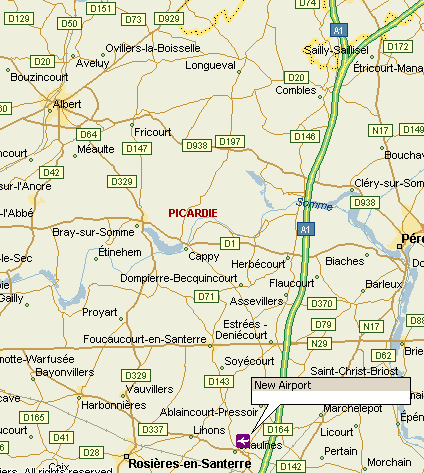
Source: THE SUN 16th November 2001.
WAR
GRAVES TO BE DUG UP FOR SOMME AIRPORT.
By
MIKE DARVILL
BRITISH
war veterans last night erupted in fury at moves to build an airport on a SOMME
battlefield. French PM Lionel Jospin yesterday chose the site in a region where
100,000 British troops died during the infamous 1916
offensive – for a third Paris airport. Some 23,000 soldiers' graves,
including those of 25 Britons, will be dug up to make way for the air port at
Chaulnes, 80 miles north of the capital.
Barely
150 of the FIVE MILLION Brits who fought in the First World War are still alive,
But
Somme veteran Albert 'Smiler' Marshall, 104, of
Ashtead, Surrey, spoke for them, all yesterday when he
stormed: "They should build the airport somewhere else. The graves
shouldn't be moved."
Mike Johnson of the Commonwealth War Graves Commission said: "We haven't been consulted - and we object vigorously. "Relatives of those buried there will be most upset."
A
Royal British Legion spokesman said: "Thousands of our members will be
angry because of what the Somme represents. And I think the country as a whole
will have strong feelings about this." Dennis Goodwin, of the First World
War Veterans' Association, said: "To disturb the graves of people who
fought on French soil is an insult."; A small British cemetery containing
25 Tommies’ graves from the second Somme' offensive in. 1918,. Will be moved
as will a French cemetery containing six Brtis’ remains.
But
almost 23,000 German graves must uprooted - because one of the biggest German
war cemeteries in France is on the line of one runway.. All
the soldiers' remains are expected to be moved to other Somme cemeteries. The
Brit graves are on land granted "in perpetuity"
by the French state. But that government has the power to
make a compulsory purchase if it is "in the national interest".
Construction
on the new' airport will start next year. A spokesman
for the Transport Ministry in Paris said “It is deeply regrettable that the
graves will have to be moved. It will be done with the deepest
respect and sensitivity. "This airport is of major
importance to France. Construction must go ahead.
The
government warnts it built to ease congession at Charles de Gaulle, north east
of the capital and Orly, to the south.
Buts
critics including French Environment Minister Yves Crochet doubt it is needed - especially
at a site so far out of Paris.
The
location, halfway between Paris and Calais, was chosen to quell protests about
aircraft noise in the capital's suburbs.
The
new airport will be two hours from London once the high-speed rail line through
Kent is completed.
Source: THE COMMONWEALTH WAR GRAVES COMMISSION web site (Whats New) 16th November 2001.
The Commission is aware that the recent announcement by the French Government that a site near Chaulnes on the Somme has been chosen for a third Paris airport has raised concerns that war graves might be disturbed.
As yet the Commission has seen no details of what is proposed and until these are received from the French authorities it is not possible to say what the implications might be. Chaulnes is in an area of the Somme where there are few Commonwealth war burials and there is therefore no certainty that any will be affected by the proposals.
The French
Government has in the past avoided the need to disturb war cemeteries when
similar developments have taken place e.g. the TGV fast rail link and we have no
reason to believe that they will act any differently in this instance.
Source: THE WESTERN FRONT ASSOCIATION web site 16th November 2001.
Despite the collapse in air travel since 11 September and despite evidence that Paris has no pressing need for a third big airport, Lionel Jospin, the Prime Minister, will approve plans tonight to build a futuristic terminal at Chaulnes, almost halfway between Paris and Calais. The government hopes eventually that the airport, designed for long-haul flights, will draw traffic from Britain and other countries.
At least one village will have to be destroyed and three largely dismantled to make way for the airport, next to the high-speed railway to London, Brussels and Lille. The site, controversial for several reasons, will force the first mass removal of graves of soldiers killed in the First World War.
A small British cemetery containing the remains of 20 soldiers killed in March 1918, on land granted "in perpetuity" by the French state, like all British war cemeteries, falls within the proposed airport boundary. So does a large French military cemetery, also containing six British graves.
The 15-year construction of the terminal will also force the removal of the bodies of 22,665 German soldiers, in one of the largest German war cemeteries in France, now occupying the site of what will be the airport's northern runway.
Mike Johnson of the Commonwealth War Graves Commission said no British war cemetery in France had been moved before. "We would object vigorously," he said. Eckhardt Holtz, of the German war graves authority in Metz, said his first reaction had been that moving so many graves was impossible. "But if the French insist, and they pay to build another cemetery elsewhere, and they are moving their own cemetery near by, I suppose we cannot stand in their way."
Press reports say Chaulnes will be selected from a shortlist of eight possible airport sites by Mr Jospin and a group of ministers in Paris. The location has been chosen, in part, to relieve protests against air traffic noise in the Paris suburbs. But the site has also been pushed vigorously by Air France, the state-owned airline, which hopes the inter-continental terminal will attract passengers from Belgium and from Britain.
The airport will be less than two hours from London by rail once the high-speed line through Kent and eastern London is completed. It will be 30 minutes from Paris by TGV and 45 minutes from Brussels.
But the choice of the Chaulnes area has infuriated people living there. "It is our memories, our childhoods that they are rubbing out," said Ghislaine Caussin, 71, whose home in the village of Vermandovillers stands in the middle of what will become a main runway.
Raphael Poupard, 61, the Mayor, is struggling to mount a rearguard action from his one-room town hall, with one telephone line and no fax machine. "Look at the map," Mr Poupard said. "The other threatened villages may survive a little but we will be wiped out 100 per cent. Vermandovillers will be scratched from the map of France. And why? No airport built so far from a city has ever succeeded."
Mr Poupard has a point. Although the Chaulnes site seems logical, next to a junction of two motorways and the TGV line to the north, its apparent advantages are misleading. The A1 motorway to Paris is already choked. The TGV line is running at full capacity. Two new tracks would have to be added all the way to Paris to serve the airport. Northern France is, in any case, an air traffic bottleneck. Putting the airport south of Paris would have made more sense.
Yves Crochet, the French Environment Minister, who is from the Green party, says there is no need for a third airport, after Charles de Gaulle and Orly. The complaints of pressure groups in the Paris suburbs could be met by trans- ferring freight and other flights to the provinces.
But this misses the real argument. The promise of expansion at an intercontinental airport within 15 to 20 years will give Air France a huge advantage in the battle for domination of the European skies, as smaller carriers disappear. Putting that airport within a short high-speed train ride of Britain, Belgium, the Netherlands and Germany will, Air France hopes, prove to be a strategic masterstroke.
Paul
Sorry for the delay in getting back to you but as you can imagine we have been
fielding questions all morning on this issue.
The first thing to say is that I do not think we should jump to conclusions
until we have all the facts on what is proposed by the French authorities and
the implications for war graves. We are of course seeking clarification on these
points and it is probably premature to react until we know more.
As you will know the area around Chaulnes was part of the French area of
operations and the Commonwealth burials in the area are few in number. We
understand from secondary sources that the cemetery most likely to be affected,
in which there are Commonwealth War burials, is the French National Cemetery at
Lihons in which there are 6 Commonwealth burials. Also on the fringes of the
area is Rosieres British Cemetery with 60 burials but I must stress that we have
no indication of any definite proposal to disturb these burials. The
Commission's policy is of course clear and we would be opposed to any
disturbance.
The French have an excellent record of avoiding disturbance and the works
surrounding the building of the TGV route and motorway construction in the area
of the battlefields was undertaken with the need to avoid war cemeteries very
much in mind. There is no need to think that they will not be equally concerned
to avoid unnecessary disturbance in this instance.
The land on which the cemeteries were constructed was given for the Commission
to use without time limit despite the various interpretations of the term in
perpetuity and we do not consider that there is any general threat to the
cemeteries.
I hope this is of use. We are considering putting something up on our web site
but we also wish to establish more facts.
Regards
David
Source: THE COMMONWEALTH WAR GRAVES COMMISSION web site (Whats New) 31st October 2001.
THE 25,000th SOUNDING OF THE LAST POST AND THE FUNERAL OF PRIVATE HARRY WILKINSON
From the earliest months of the First World War, Ieper, or Ypres as it was then known, stood as a potent symbol of Allied tenacity and resistance on the Western Front. Images of the devastated town are familiar, and although painstakingly rebuilt, Ieper is today surrounded by the most tangible reminders of those years.
In Belgium, the Commission cares for more than 200 Commonwealth war cemeteries, war graves in more than 400 communal cemeteries and churchyards, and six memorials to the missing. Most of the 205,000 war dead of the Commonwealth commemorated in Belgium died during the First World War and almost half of that total have no known grave. These cemeteries and memorials are cared for by the Commission’s office in Ieper, which also has responsibility for Commonwealth war graves across northern Europe. "Today, most of our 140 administrators, gardeners and craftsmen are local people," said Jerry Gee, the Commission’s director in Ieper. "We have had a base here since the Commission’s earliest days, and over the years we have developed a special relationship with the town."
Defended by Commonwealth forces for much of the war, the density of our cemeteries in the Ieper area is astonishing, and the most significant of the Commission’s memorials to the missing in Belgium, the Menin Gate, stands in the town itself, straddling the road that thousands of troops would have taken as they passed through the shattered town on their way to the trenches of the Ypres Salient. The memorial bears the names of 54,000 servicemen whose graves are not known, but is very much seen as a focal point for the remembrance of all those who gave their lives on this part of the front.
On 31 October 2001, men of the Ieper Fire Brigade will sound the last post beneath the arches of the Menin Gate Memorial for the twenty-five thousandth time. It may be more than 80 years since the First World War ended, but by this nightly act of remembrance - suspended only during the occupation of the Second World War - the people of Ieper show that the memory of those Commonwealth forces who died in the defence of their town remains a central part of their lives. Long may it continue.
The Commission’s work of ensuring that those members of the Commonwealth forces who gave their lives during the two world wars are not forgotten is certainly rooted in the past, but it is as significant and immediate today as it was in 1917. The remains of our war dead are still being discovered and on the morning of 31 October, Private Harry Wilkinson of the Lancashire Fusiliers, who was killed in action in November 1914, will finally be laid to rest at Prowse Point Military Cemetery.
The daily sounding of the Last Post as a memorial to those commemorated on the Menin Gate began on 1st July 1928. Originally held at sunset, the ceremony now takes place at 2000 hrs every day except on significant days such as Remembrance Day when it is also played at 1100 hrs. The Memorial itself will be 75 years old next year and events are planned to coincide with this anniversary.
BURIAL OF FIRST WORLD WAR FUSILIER ON 25,000 th LAST POST ANNIVERSARY
Private 8850 Harry Wilkinson, 2nd Battalion Lancashire Fusiliers, was killed on 10 November 1914 and is to be buried with full military honours at Prowse Point Cemetery, Commines-Warneton, Hainaut, Belgium at 1100 hrs on 31st October
On the same day a short ceremony will be held at 1730 hrs to commemorate the 25,000th sounding of the Last Post at the Menin Gate at Ieper, Belgium (Ypres in French) in the presence of HRH the Duke of Edinburgh and HRH Prince Phillipe of Belgium.
As part of the Commemoration a different soldier, sailor or airman killed during the 1914-1918 War is to be honoured each day for a year. Pte Harry Wilkinson will be the first to be honoured in this way at the regular sounding of the Last Post at 2000 hrs on 31 October.
The remains of Pte Wilkinson, who came from Bury, Lancashire, were discovered at Ploegsteert Wood, Belgium. The UK MOD confirmed his identity through forensic examination and artefacts found with him including his identity disk bearing the legend ‘8850 H Wilkinson CE LF’. The funeral, with full military honours, will be conducted by British Army Regimental Padre Mark Moreton and attended by members of Pte Wilkinson’s family, HRH The Duke of Kent President of the Commission, Mr Gavin Hewitt CMG British Ambassador to Belgium, Brig R M Wilde CBE and Col B Gorski representing the Lancashire Fusiliers and Gp Capt J Bullen Defence Attaché Belgium. Ceremonial duties will be carried out by 1st Battalion The Royal Regiment of Fusiliers.
CANADIANS TO ATTEND 25,000th PLAYING OF LAST POST AT THE MENIN GATE IN BELGIUM
Halifax, NS - A delegation of approximately 75 Canadians has left for Europe,
where they will attend a ceremony to mark the 25,000th playing of the Last Post
at the Menin Gate in Belgium. The delegation will also attend the burials of
Second World War soldiers, Private Charles Joseph Beaudry and Private George
Robert Barritt, and participate in ceremonies of remembrance in France, Belgium
and The Netherlands.
On behalf of the Honourable Ron J Duhamel, Minister of Veterans Affairs and Secretary of State (Francophonie) (Western Economic Diversification), Carmen Provenzano, Parliamentary Secretary to the Minister of Veterans Affairs, will lead the Canadian delegation, which includes heads of veterans' organisations, relatives of Private Beaudry and Private Barritt, and members of the Lincoln and Welland Regiment and the 85th Battalion, Nova Scotia Highlanders.
"The aim of this trip is to pay tribute to those who gave their lives in war so that future generations might live their lives in peace," said Mr Provenzano. "I know that each member of the delegation will come home moved by what they have seen".
While in Europe, the delegates will also attend the rededication of a First World War memorials to Canada's 85th Battalion in Passchendaele, Belgium, and remembrance ceremonies at the Beaumont-Hamel Newfoundland Memorial and the Canadian National Vimy Memorial, both in France.
The delegation will also pay their respects at the Canadian memorials at Passchendaele, Hill 62, and St-Julien, as well as at the Tyne Cot Commonwealth War Graves Commission Cemetery. They return to Canada on November 5.
Source: THE SHROPSHIRE STAR 31st October 2001.
Soldier laid to rest 87 years after his death.
By Sarah Bullock
A Shropshire woman today swept away the tears
as her great grandfather who was killed during the First World War was finally
laid to rest more than 87 years after his tragic death.
Private 9950 Harry Wilkinson, of the 2nd Battalion
Lancashire Fusiliers, was killed in action on November 10, 1914, in a field in
Belgium. But his remains -with identity tag-were only found 87 years later
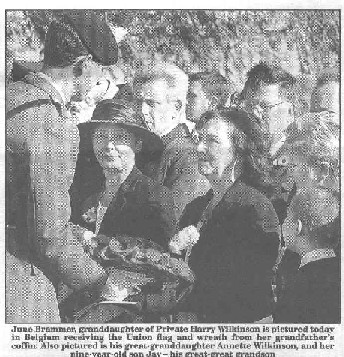 They were discovered, along with his Lancashire
Fusiliers cap badge in January last year in a field at Ploegsteert Wood. His
great granddaughter, Annette Wilkinson, of The Meadows, Shawbury, today attended
the funeral at Prowse Point Cemetery, Commines-Warneton, Hainaut, Belgium. The
ceremony with full military honours was con- ducted by British Army Regimental
Padre Mark Moreton and was attended by the Duke of Kent who is President of the
Common- wealth War Graves Commission.
They were discovered, along with his Lancashire
Fusiliers cap badge in January last year in a field at Ploegsteert Wood. His
great granddaughter, Annette Wilkinson, of The Meadows, Shawbury, today attended
the funeral at Prowse Point Cemetery, Commines-Warneton, Hainaut, Belgium. The
ceremony with full military honours was con- ducted by British Army Regimental
Padre Mark Moreton and was attended by the Duke of Kent who is President of the
Common- wealth War Graves Commission.
The Duke of Kent greeted family members of Pte
Wilkinson, including his great-granddaughter Mrs Wilkinson, 51, and his great-
great grandson Jay, 9, also from Shawbury. He stopped to speak to them before
exchanging a few words with Lt Col David Paterson of the 1st Battalion, the
Royal Regiment of Fusiliers.
The coffin was carried by six members of the 1st
Battalion to sombre music from the Minden Band from the Queen's Division based
in Germany.
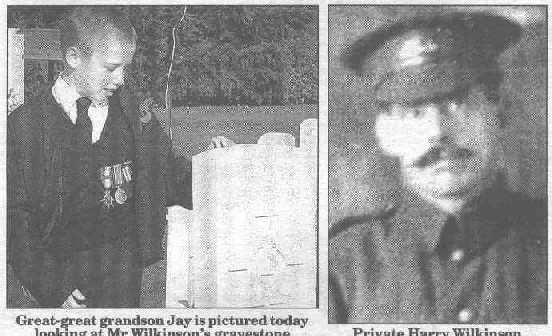 The
coffin bearer’s care- fully removed the Union Jack, a wreath of poppies and
Fusilier cap from the top of the coffin as they knelt, beside it. Before the
service Mrs Wilkinson said: "I will be happy when it is over with because
he has waited a long time for a burial. "It
will be nice to put him to rest. " A row of six soldiers fired three
shots over the grave as the coffin was carefully lowered.
The
coffin bearer’s care- fully removed the Union Jack, a wreath of poppies and
Fusilier cap from the top of the coffin as they knelt, beside it. Before the
service Mrs Wilkinson said: "I will be happy when it is over with because
he has waited a long time for a burial. "It
will be nice to put him to rest. " A row of six soldiers fired three
shots over the grave as the coffin was carefully lowered.
Source: THE DAILY TELEGRAPH 1st November 2001.
By SALLY POOK IN YPRES
FOR more than 85 years the
body of Harry Wilkinson lay forgotten in the mud of Flanders, seemingly lost
forever on one of the bloodiest battlefields of the First World War. The
Lancashire Fusilier was killed during 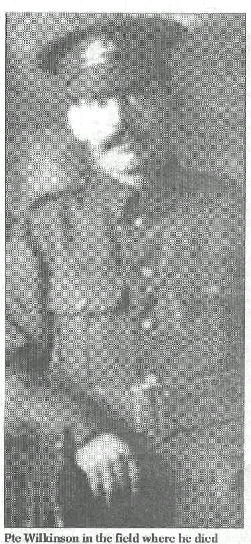 the first
Battle of Ypres in November 1914, leaving a six- year-old son and a wife, Eva,
who was pregnant with his daughter. Buried where he fell, his grave unknown and
unmarked, Pte Wilkinson's body remained undiscovered for generations until last
year when a farmer chose to plough a field for the first time since 1914.
the first
Battle of Ypres in November 1914, leaving a six- year-old son and a wife, Eva,
who was pregnant with his daughter. Buried where he fell, his grave unknown and
unmarked, Pte Wilkinson's body remained undiscovered for generations until last
year when a farmer chose to plough a field for the first time since 1914.
Unearthed beside his skeleton were
fragments of uniform, his identity tag, a pipe and a bottle of rum. His arm
appeared thrown over his head as if to protect him- self from a shell blast. Pte
Wilkinson's family were unaware that their posthumously decorated grandfather
still lay on the Ypres Salient, along with tens of thousands of young men whose
remains were never found. His was the first body to be found and identified in
Belgium for 20 years. Yesterday, with four generations of his family looking on,
his funeral was held, with full military honours, in a battlefield cemetery a
few hundred yards from where he fell.
"It is very emotional for us, to see him properly
buried after all this time," said June Brammer, Pte Wilkinson's
grand-daughter, whose mother was the daughter he never saw. "We had no idea
he was still lying on the battlefield. "We will never know for definite how
Harry was killed, but we know he had a wound to his head. We believe his
comrades knew he wasn't going to make it, so they covered him with his overcoat
and left him with some rum."
Pte Wilkinson, who had been a fire-beater at Bury
cotton mill, landed in France two months before his death on the Western Front.
After fighting at the Marne and Aisne, he was sent to the front line near
Ploegsteert Wood on the Ypres Salient. The following day, he sent a postcard to his wife with the
wish "May God be with you until we meet again".
Pte Wilkinison was among men from 2 Battalion ordered to support the 2nd Argyll and Sutherland Highlanders in a night counter- attack. They bayoneted their way through German trenches and seized a farmhouse but four of the Lancashire’s, including Pte Wilkinson, were killed Pte Wilkinison's widow, who never remarried, was told in a letter of condolence sent with a death plaque from the King that he had been awarded three medals posthumously: the Mons Star, the War Medal and the Victory Medal.
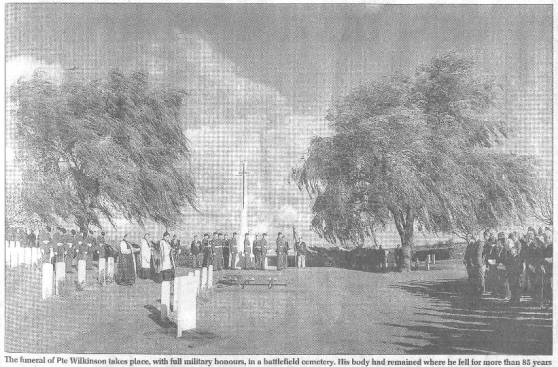
Mrs Brammer, who was three when Eva died, said: "I vaguely remember her. She must have had a very hard time. Fortunately she had a big family who helped her, although I think three of her brothers did not come back from the war." Yesterday, Pte Wilkinson's medals were worn by his great-great grandson, Jay Wilkinson, nine, who watched as the remains of his distant relative were lowered into a grave at Prowse Point Military Cemetery, just south of Ypres. Asked what he knew of Pte Wilkinson, he said: "I just know he was a hero of the First World War."
Mrs Brammer, 59, and Annette Wilkinson, 51, Pte
Wilkinson's great grand-daughter, were visibly moved during the service, which was attended by
the Duke of Kent and soldiers from 1 Battalion Royal Regiment of Fusiliers. The
regiment was formed from four others in 1968, including the Lancashire
Fusiliers.
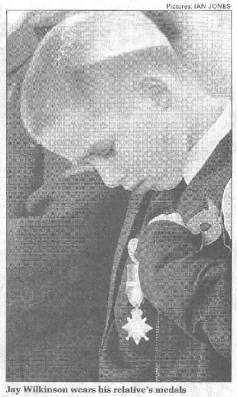 After the salute by the firing party, Last Post was
sounded, before the Colonel of the Regiment read the exhortation: "At the
going down of the sun, and in the morning, we will remember them." The
Reverend Ray Jones, chaplain of St George's Memorial Church, told those
gathered: "We should rejoice in the opportunity to pay tribute to a soldier
who has lain forgotten for so long and who is now, in a sense, reunited with his
family and his regiment." Later, a ceremony attended by the Duke of
Edinburgh marked the 25,000th sounding of Last Post at the Menin Gate,
which commemorates the 55,000 British and Commonwealth soldiers who died in the
Salient and whose whereabouts remain unknown.
After the salute by the firing party, Last Post was
sounded, before the Colonel of the Regiment read the exhortation: "At the
going down of the sun, and in the morning, we will remember them." The
Reverend Ray Jones, chaplain of St George's Memorial Church, told those
gathered: "We should rejoice in the opportunity to pay tribute to a soldier
who has lain forgotten for so long and who is now, in a sense, reunited with his
family and his regiment." Later, a ceremony attended by the Duke of
Edinburgh marked the 25,000th sounding of Last Post at the Menin Gate,
which commemorates the 55,000 British and Commonwealth soldiers who died in the
Salient and whose whereabouts remain unknown.
It has been sounded every day since July 1928. As part
of the anniversary, a different soldier, sailor or airman killed in the Great
War is to be honoured each day for a year. Pte Wilkinson is the first. Before
Mrs Brammer left the cemetery she laid a wreath at her grandfather's grave. It
read: "Harry, lost but now found. May you now rest in peace."
Source: THE DAILY TELEGRAPH 13th October 2001.
Veterans
gather to hear 25,000th Last Post at Ypres.
By A J McIroy
VETERANS of the First World War are preparing to
travel amid tight security to Belgium for the 25,000th sounding of
Last Post at the Menin Gate Memorial in Ypres. The men, all centenarians, will
be joined by Prince Philip on act 31 at the simple ceremony which, except for
the German occupation during the Second World War, has taken place every night
since 1928 to honour the 330,000 Allied servicemen who died in four great
battles around the town.
Among them will be Fred Bunday, 101 next month and
reputedly the youngest of the survivors. "It is sad that all these years
after what was supposed to be the war to end all wars we still have war and have
to worry about our safety," he said yesterday at his home in Sidcup, Kent.
"Not that what is happening now can be compared with wars between opposing
armies. There is a cruelty about attacks on civilians going about their normal
lives.
Mr Bunday, who was, awarded the Legion d'Honneur by
France four years ago, joined the Royal Navy at 15 and served through both world
wars. "Three ships sank under me in the Mediterranean and I often think of
comrades who never got the chance to be honoured," he said. "I am off
this afternoon to a tea dance and am lucky to still have my health and be able
to travel. No matter how many times I attend ceremonies in memory of fallen
comrades the feeling of loss never gets any less. In fact, it grows with the
passing of time."
Dennis Goodwin, of the World War One Veterans'
Association, said: "Our numbers are dwindling, down to some 70 or so now.
Some are aged 105 and over. From Britain, Fred Bunday will be joined on October
31 by George Stone - he is 101 years old - who comes from Oxfordshire and is
another Royal Navy veteran."
Last
British Veteran of Gallipoli dies, aged 106.
By
BARBIE DUTTER IN SYDNEY
THE
last known British veteran of the Gallipoli campaign has died in an Australian
nursing home at the age of 106. Despite
seeing comrades killed, losing a leg to gangrene and almost succumbing to
exposure, Percy Goring considered himself fortunate to have escaped with his
life. "I
survived only because I had the best of luck from the start. My mates at
Gallipoli called it Mr Goring's Good Luck," he said earlier this year.
Mr
Goring was known fondly as a "Digger", albeit a British one, in his
adopted home town of Bunbury, Western Australia, where he lived for more than
half a century. His survival had remained unknown to
the authorities until last year when an amateur military historian uncovered his
story. Mr Goring's death on Friday leaves only
one Australian Gallipoli survivor, 102-year- old Alec Campbell from Tasmania.
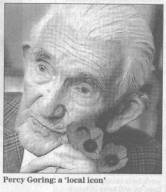 Born in
Shoreditch, east London, Mr Goring enlisted in the Royal Engineers. He had no
idea where Turkey was when the invasion fleet set sail in 1915. About 34,000
Allied soldiers were killed during the unsuccessful. assault on Turkish
positions.
Born in
Shoreditch, east London, Mr Goring enlisted in the Royal Engineers. He had no
idea where Turkey was when the invasion fleet set sail in 1915. About 34,000
Allied soldiers were killed during the unsuccessful. assault on Turkish
positions.
After
the First World War, Mr Goring returned to the family millinery business, which
at that time was making Australian slouch hats.
He
migrated to Australia in 1948, and took a series of jobs before running a farm
with his wife near Bunbury.
Mr
Goring, who proudly took part in Anzac Day commemorations in April, was
described as "a local icon" by Bunbury's deputy mayor, Tom Dillon.
Well
into his 100s, he was a common sight touring around town in his electric wheel
chair. But Chris Mills, president of the Bun bury Returned and Services League,
said MI Goring had also suffered bouts of loneliness "He said, 'I have no
contemporaries I can talk to - there's no one with my experiences'."
Source: THE SHROPSHIRE STAR Thursday, July 26, 2001.
Somme Soldier dies, aged 106.
One of the last remaining survivors of a historic First World War battle has died at the age of 106.
Bertie Felstead survived the Battle of the Somme in 1916 and was one of the soldiers who crossed no mans land in France to celebrate Christmas with the Germans during the unofficial truce.
The great great grandfather spent his last 16 years in Podsmead Court care home, Gloucester, where he died.
Source: THE DAILY TELEGRAPH Thursday, July 26, 2001.
LAST
SURVIVOR OF SOCCER TRUCE DIES.
BERTIE
Felstead, the last survivor of the First World War Christmas Day truce when
British and German troops played football together, has died aged 106.
Mr
Felstead, the second oldest person in Britain, was by his own account an average
man who experienced an extraordinary event. His whole life was dominated by that
moment in history" in 1915 (1914) when the guns went silent and
British and German troops emerged from the trenches to play football in the
snow.
He
was even included in the book Centurians, a list of the most culturally
influential people of the 20th century.
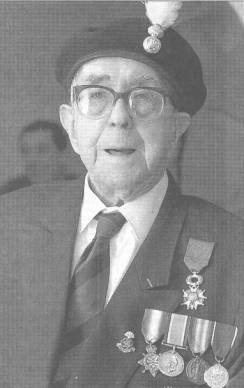 Born in
High gate, north London, on Oct 28, 1894, Mr Felstead was a young Royal Welch
Fusilier when he and his colleagues put down their rifles and climbed out of
their icy trenches to greet the enemy.
Born in
High gate, north London, on Oct 28, 1894, Mr Felstead was a young Royal Welch
Fusilier when he and his colleagues put down their rifles and climbed out of
their icy trenches to greet the enemy.
Men
who had been sniping at each other for months stopped the killing for a few
hours.
He
was spending his first Christmas Eve in northern France when he and his
colleagues, shivering in their trench near the village of Laventie, heard the
carol Silent Night wafting over from the German lines 100 yards or so
away.
"It
wasn't long before we were singing as well. Good King Wenceslas, I think
it was," he said in an interview two years ago.
"You couldn't hear each other sing like that without it affecting your
feelings for the other side.
"The
next morning, Christmas Day, there was some shouting between the trenches.
'Hello Tommy, Hello Fritz,' that sort of thing and that broke a lot more ice. As
far as I can remember, a few of the Germans came out first and started walking
over. I do remember a whole mass of us just
getting up and going out to meet them. Nothing was planned. It was spontaneous.
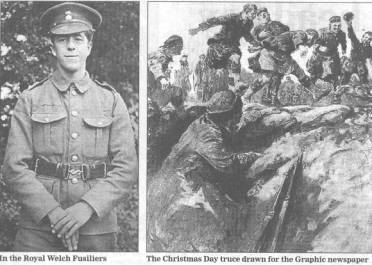 "There
was a bit of football; if you can call it that. Someone suggested
it and somehow a ball was produced. I don't know were from. It wasn't a game as
such - more of a kick-around and a; free- for all. There could have been 50 on
each side for all I know. "I played because I really liked, football. I
don't know how long it lasted, probably half an hour and no one was keeping
score."
"There
was a bit of football; if you can call it that. Someone suggested
it and somehow a ball was produced. I don't know were from. It wasn't a game as
such - more of a kick-around and a; free- for all. There could have been 50 on
each side for all I know. "I played because I really liked, football. I
don't know how long it lasted, probably half an hour and no one was keeping
score."
The
truce came to an end with the appearance of an angry British major, barking out
orders to return to the trenches and terse reminders that they were there to
"kill the Hun not make friends with him". A British artillery salvo
finally shattered the mood. "The Germans were all right," said Mr
Felstead, who was wounded on the Somme in 1916 and shipped back to England.
After
recovering from injury, Mr Felstead volunteered for overseas service and fought
in Salonika in 1917 until being evacuated home with acute malaria.
Demobbed in 1919, Mr Felstead worked as a store man at an RAF base in Uxbridge, London. Mr Felstead married on Mar 16, 1918. His wife, Alice, died in 1983. He died on Sunday, at a Gloucester nursing home. He is survived by two of his three daughters, five grandchildren, II great-grandchildren and two great great grandchildren.
22nd June 2001
Source: THE DAILY TELEGRAPH Friday, June 22, 2001.
FAMILIES UNVEIL MEMORIAL TO DESERTERS.
See Shot at Dawn page.
20th June 2001
Source: THE DAILY TELEGRAPH Wednesday, June 20, 2001.
EVEN IN DEATH, VICTIMS OF ARRAS STAYED SIDE BY SIDE
THE determination of soldiers to preserve dignity in
death during the carnage of the First World War has been graphically illustrated
by a photograph of the remains of 20 British infantrymen killed in northern
France 84 years ago.
The
picture, taken this week at a construction site for a BMW factory near Arras,
shows the skeletons of bodies laid carefully side by side "out of respect
and to help future identification and reburial".
Regimental
badges showed that most of the men were from the 10th Battalion the Lincolnshire
Regiment, know as the "Grimsby Chums", but identity discs and other
possessions did not survive -to enable them to be identified.
Nick
Smith, a spokesman for the Adjutant General's department charged with
identifying remains of soldiers and finding relatives, ~ said yesterday:
"This picture is remarkable evidence of the care taken by soldiers of their
dead comrades in circumstances hard to imagine.
"This was ground captured and recaptured during
the campaign. In many instances carefully laid temporary graves were destroyed
in the artillery barrages. This one has survived."
He
said it was extremely unlikely the skeletons would be identified. "If the
war graves commission tells us of items recovered with the bodies that might
give a clue as to identity we would send our forensic expert to the scene. But
that has not been the case.
"It
is rare all these years later that there is anything found to help with
identification. It is usual that the bodies of soldiers still being recovered
are reburied with full military honours at a war graves site nearest to where
they have been found rather than being brought home."
Roy Hemington, of the Commonwealth War Graves Commission, said the men, and the remains of four others found nearby, were killed while taking part in a major Allied offensive at Arras in April 1917 .
Alain
Jacques of the Arras Archaeological Survey, who was,
among those who discovered the grave, said: 'It's very hard for us; it's like
it's our grandfathers.
"It
looks like they were in a, danse macabre. They were holding each other by
the arm, perhaps to signify that they were from the same unit."
Twenty
of the men were found together in a common grave, three in a shell-hole and the
last -from the Royal Navy Division, nearby. The division was made up of sailors
from ships decommissioned for the period of the war and sent to serve in the
trenches.
Each
year in France the remains of around 20 Commonwealth soldiers are found, usually
during building or farming work. Very few are identified.
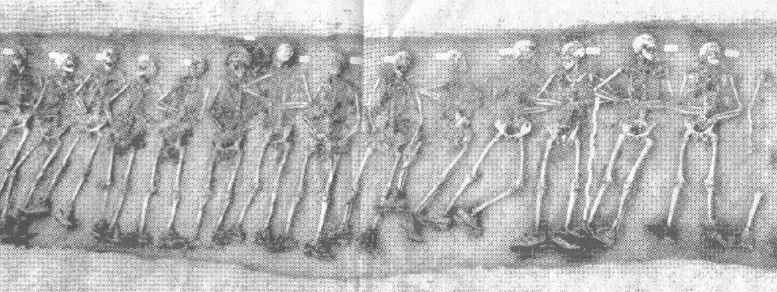
Comrades
in arms: the bodies of the British Soldiers who fell at Arras were laid out
shoulder to shoulder in the 15 yard grave. Badges showed that most of the men
were from the 10th Battalion the Lincolnshire Regiment.
Source: THE DAILY TELEGRAPH Thursday, June 21, 2001.
WAR GRAVE REVIVES TOWN'S MEMORIES OF 'CHUMS' WHO FOUGHT AND DIED TOGETHER Follow-up story
THE remains of 20 unknown British soldiers found in a French war grave
have rekindled an 84-year-old nightmare for the people of a Lincolnshire fishing
community that paid a heavier price than most in the First World War.
Identified by their badges as members of the 10th Bn the Lincolnshire Regiment, most of the men are believed to have belonged to the Grimsby Chums, a unit whose story is one of the, proudest and most tragic of the war.
Yesterday Grimsby pondered once again on the heroism of its lost sons and
the strategic blunder that led to hundreds of men from the same streets, schools
and social organisations being sent to fight and die shoulder to shoulder.
Canon Michael Hunter, 60, the town rector, in whose church there is a
memorial to the estimated 600 Chums who never returned home, said yesterday:
"The town lost its finest. Their suffering and their endurance is
legendary."
The
idea of forming battalions from volunteers of common background, attributed to
the then secretary of war, Lord Kitchener, resulted in about 304 such units
being formed. Most called themselves "Pals" battalions. Only one, that
from Grimsby, coined the name Chums.
They fought on the Somme, where 15 officers and 487 men were killed,
missing or wounded on July 1, 1916 in one of the worst debacles of the war. A
year later they joined the battle at Arras where the forgotten war grave has
been unearthed on the site of a new car factory.
The story is told of an officer who, to give his men’s spirit a lift,
walked along the trench-top in view of the enemy imitating Charkie Chaplin and
twirling his walking stick. The reward for such bravardo was to be shot and
wounded.
Peter Croft, Grimsby British Legion’s Welfare Officer, said: “about
1,000 men volunteered from a community that in those days wasn't much more than
A year a big village. They had no idea what horrors they
faced.
"They signed on at the town recruiting office, full of patriotism
and hope, and went to Lord Yarborough's estate at Brocklesbury to do basic
training before going off to the front line," he said. 'Most of them never
came back.
"Every family, every street seemed to have its losses. Those that
did return were not the same men again.
"It was a nightmare that the whole town shared and
never forgot. The experience has
been passed down the generations."
The town's Wintringham Grammar School, which is
now a 600-pupil comprehensive, lost 80 of its old boys. An iron plaque on the
wall lists their names and pupils are taken to gaze at it as part of modern
history lessons.
Graham Shuttleworth, the assistant headmaster, said: "It's hard for
them to around who could recall the horrors first-hand but not any more. For
today's children it is something from another age."
The last of the Chums, John
Barker, died six years ago, aged 101 and was given a full military funeral as a
sign of the town's respect. Mr Barker was shot in the leg and lay all night on
the battlefield awaiting rescue, but he was one of the lucky ones.
Hisson-in-law,
John Morton, 66, a former deputy editor of the Grimsby Evening Telegraph, said:
"His war experiences affected
him deeply. He never forgot, even as a centenarian. '
Grimsby
holds its military record with pride. The Chums are still remembered at the
Cenotaph each year, in the Town Hall roll of honour and at the local museum
where albums full of sepia photographs recall the men's patriotism and pride.
Every year a party of about a dozen townspeople makes the pilgrimage to
the Somme to place flowers at a place the soldiers nicknamed Lochnagar. It was
where the young men of Grimsby were cutdown as they advanced at walking pace
towards the enemy machine guns.
Murdo
Maclnnes, 70, a retired fishery manager; who organises the outing for Grimsby
Rotary Club!, says a bench has been placed at the scene "so people can sit
quietly and think",
The skeletal remains unearthed at Arras are to be reinterred, with due
ceremony, in French soil. Grimsby is making plans to send a delegation to give
the Chums a final salute.
